KIA Sorento 2006 1.G Owner's Manual
Manufacturer: KIA, Model Year: 2006, Model line: Sorento, Model: KIA Sorento 2006 1.GPages: 312, PDF Size: 5.21 MB
Page 111 of 312
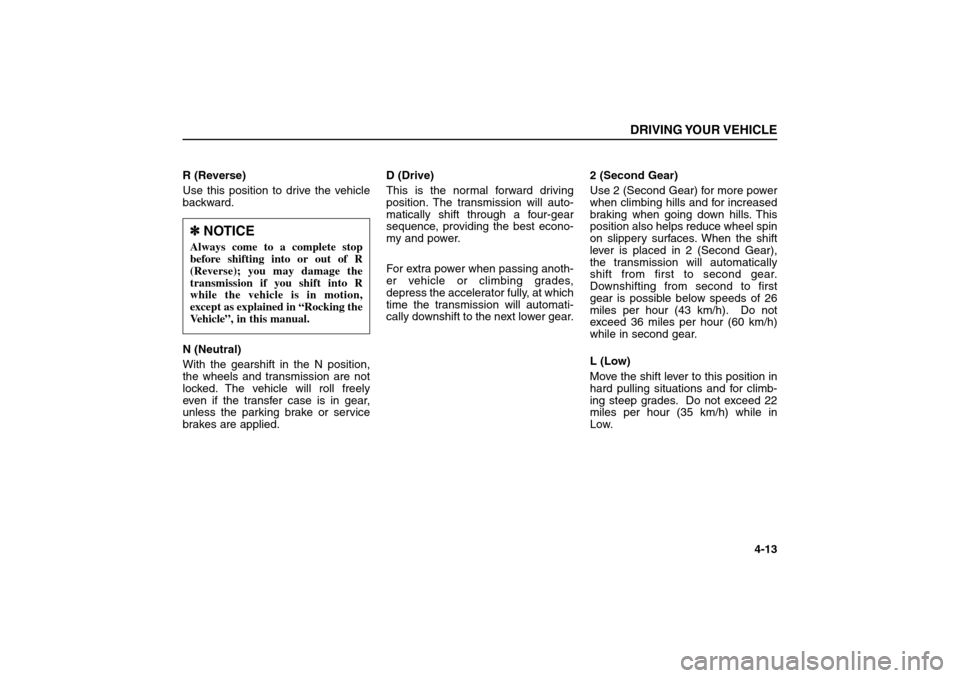
R (Reverse)
Use this position to drive the vehicle
backward.
N (Neutral)
With the gearshift in the N position,
the wheels and transmission are not
locked. The vehicle will roll freely
even if the transfer case is in gear,
unless the parking brake or service
brakes are applied.D (Drive)
This is the normal forward driving
position. The transmission will auto-
matically shift through a four-gear
sequence, providing the best econo-
my and power.
For extra power when passing anoth-
er vehicle or climbing grades,
depress the accelerator fully, at which
time the transmission will automati-
cally downshift to the next lower gear.2 (Second Gear)
Use 2 (Second Gear) for more power
when climbing hills and for increased
braking when going down hills. This
position also helps reduce wheel spin
on slippery surfaces. When the shift
lever is placed in 2 (Second Gear),
the transmission will automatically
shift from first to second gear.
Downshifting from second to first
gear is possible below speeds of 26
miles per hour (43 km/h). Do not
exceed 36 miles per hour (60 km/h)
while in second gear.
L (Low)
Move the shift lever to this position in
hard pulling situations and for climb-
ing steep grades. Do not exceed 22
miles per hour (35 km/h) while in
Low.
DRIVING YOUR VEHICLE
4-13
✽ ✽
NOTICEAlways come to a complete stop
before shifting into or out of R
(Reverse); you may damage the
transmission if you shift into R
while the vehicle is in motion,
except as explained in “Rocking the
Vehicle”, in this manual.
BL-ENG (CAN)-4.qxd 7/28/05 5:55 PM Page 13
Page 112 of 312

Moving Up a Steep Grade From a
Standing Start
To move up a steep grade from a
standing start, depress the brake
pedal, shift the shift lever to D (Drive),
2 (Second) or L (Low) depending on
load weight and steepness of the
grade, and release the parking brake.
Depress the accelerator gradually
while releasing the service brakes.
DRIVING YOUR VEHICLE4-14✽ ✽
NOTICEDo not exceed the recommended
maximum speeds in 2 (Second
Gear) or L (Low). Operating the
vehicle at speeds above the maxi-
mum recommended, for these gears
may cause excessive heat to develop
which could result in damage to or
failure of the automatic transmis-
sion.
BL-ENG (CAN)-4.qxd 7/28/05 5:55 PM Page 14
Page 113 of 312
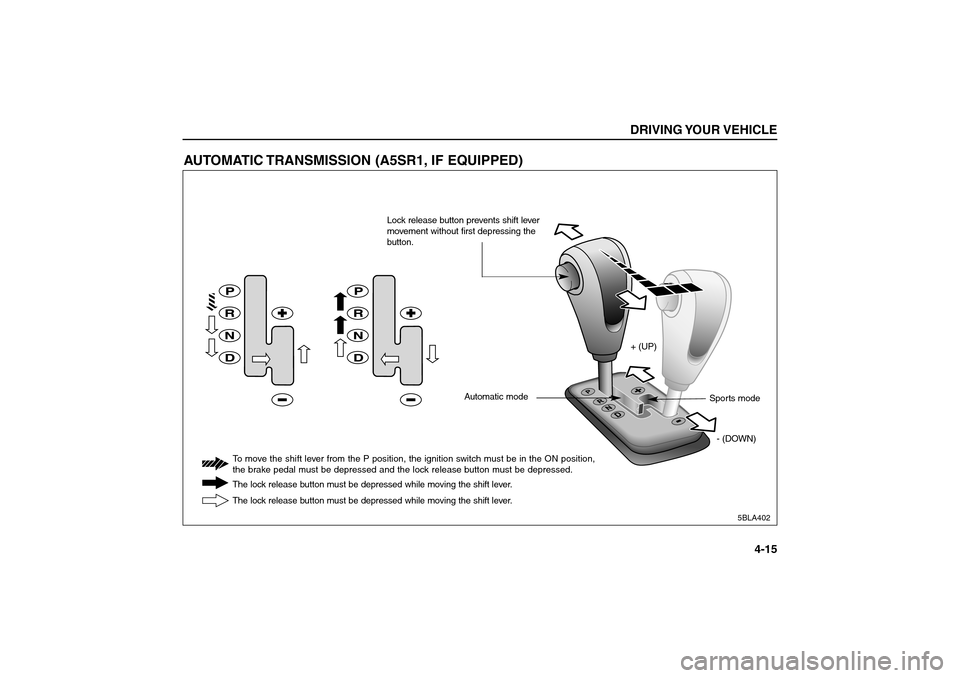
DRIVING YOUR VEHICLE
4-15
AUTOMATIC TRANSMISSION (A5SR1, IF EQUIPPED)
5BLA402
The lock release button must be depressed while moving the shift lever.
The lock release button must be depressed while moving the shift lever.To move the shift lever from the P position, the ignition switch must be in the ON position,
the brake pedal must be depressed and the lock release button must be depressed.
+ (UP)
- (DOWN) Sports mode Automatic mode
Lock release button prevents shift lever
movement without first depressing the
button.
BL-ENG (CAN)-4.qxd 7/28/05 5:55 PM Page 15
Page 114 of 312
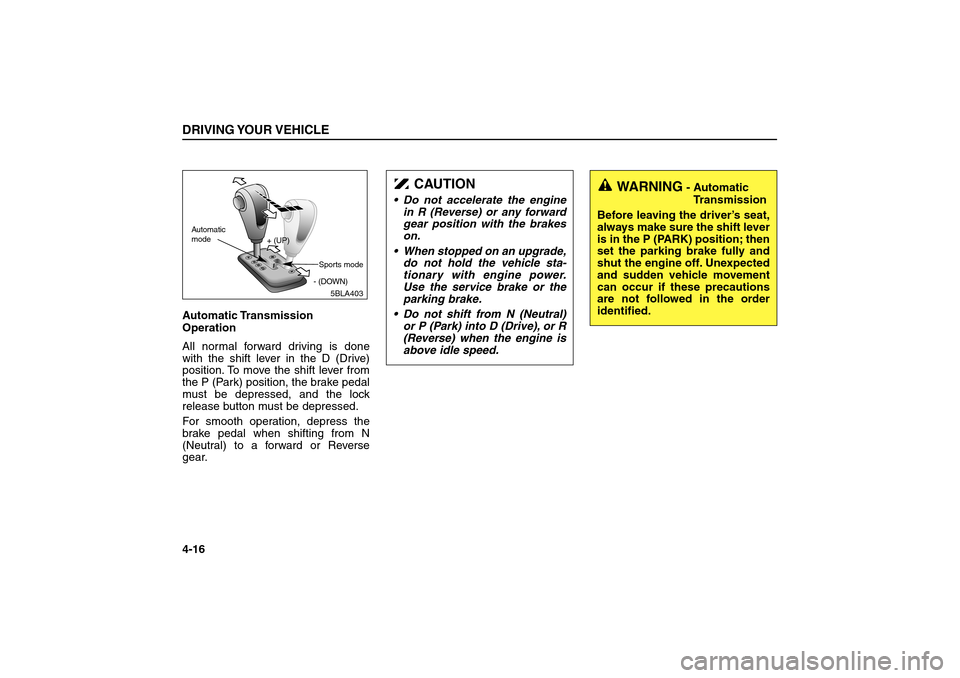
Automatic Transmission
Operation
All normal forward driving is done
with the shift lever in the D (Drive)
position. To move the shift lever from
the P (Park) position, the brake pedal
must be depressed, and the lock
release button must be depressed.
For smooth operation, depress the
brake pedal when shifting from N
(Neutral) to a forward or Reverse
gear.DRIVING YOUR VEHICLE4-16
CAUTION
• Do not accelerate the engine
in R (Reverse) or any forward
gear position with the brakes
on.
When stopped on an upgrade,
do not hold the vehicle sta-
tionary with engine power.
Use the service brake or the
parking brake.
Do not shift from N (Neutral)
or P (Park) into D (Drive), or R
(Reverse) when the engine is
above idle speed.
WARNING
- Automatic
Transmission
Before leaving the driver’s seat,
always make sure the shift lever
is in the P (PARK) position; then
set the parking brake fully and
shut the engine off. Unexpected
and sudden vehicle movement
can occur if these precautions
are not followed in the order
identified.
5BLA403 + (UP)
- (DOWN) Automatic
mode
Sports mode
BL-ENG (CAN)-4.qxd 7/28/05 5:55 PM Page 16
Page 115 of 312
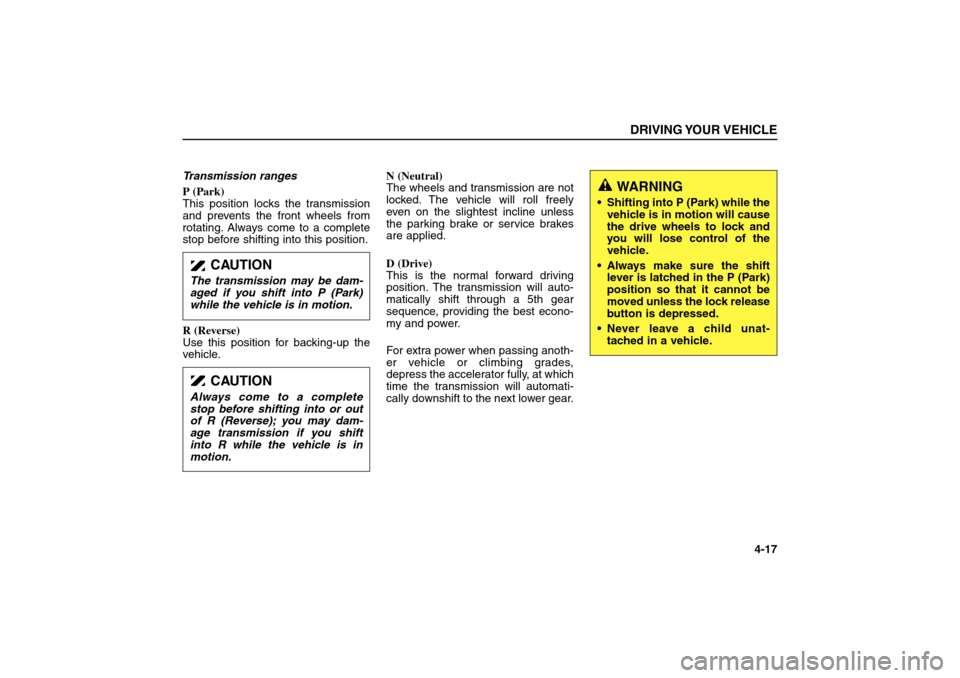
Transmission ranges
P (Park)
This position locks the transmission
and prevents the front wheels from
rotating. Always come to a complete
stop before shifting into this position.
R (Reverse)
Use this position for backing-up the
vehicle.N (Neutral)
The wheels and transmission are not
locked. The vehicle will roll freely
even on the slightest incline unless
the parking brake or service brakes
are applied.
D (Drive)
This is the normal forward driving
position. The transmission will auto-
matically shift through a 5th gear
sequence, providing the best econo-
my and power.
For extra power when passing anoth-
er vehicle or climbing grades,
depress the accelerator fully, at which
time the transmission will automati-
cally downshift to the next lower gear.
DRIVING YOUR VEHICLE
4-17
CAUTION
The transmission may be dam-
aged if you shift into P (Park)
while the vehicle is in motion.
CAUTION
Always come to a complete
stop before shifting into or out
of R (Reverse); you may dam-
age transmission if you shift
into R while the vehicle is in
motion.
WARNING
Shifting into P (Park) while the
vehicle is in motion will cause
the drive wheels to lock and
you will lose control of the
vehicle.
Always make sure the shift
lever is latched in the P (Park)
position so that it cannot be
moved unless the lock release
button is depressed.
Never leave a child unat-
tached in a vehicle.
BL-ENG (CAN)-4.qxd 7/28/05 5:55 PM Page 17
Page 116 of 312
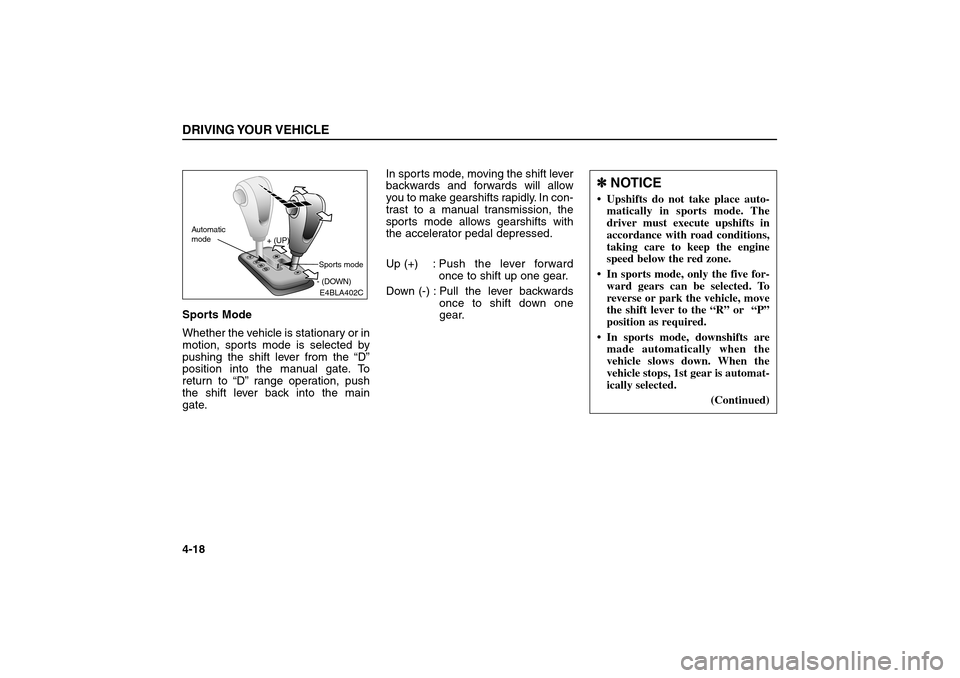
Sports Mode
Whether the vehicle is stationary or in
motion, sports mode is selected by
pushing the shift lever from the “D”
position into the manual gate. To
return to “D”range operation, push
the shift lever back into the main
gate.In sports mode, moving the shift lever
backwards and forwards will allow
you to make gearshifts rapidly. In con-
trast to a manual transmission, the
sports mode allows gearshifts with
the accelerator pedal depressed.
Up (+) : Push the lever forward
once to shift up one gear.
Down (-) : Pull the lever backwards
once to shift down one
gear.DRIVING YOUR VEHICLE4-18
✽ ✽
NOTICE Upshifts do not take place auto-
matically in sports mode. The
driver must execute upshifts in
accordance with road conditions,
taking care to keep the engine
speed below the red zone.
In sports mode, only the five for-
ward gears can be selected. To
reverse or park the vehicle, move
the shift lever to the “R” or “P”
position as required.
In sports mode, downshifts are
made automatically when the
vehicle slows down. When the
vehicle stops, 1st gear is automat-
ically selected.
(Continued)
E4BLA402C + (UP)
- (DOWN) Automatic
modeSports mode
BL-ENG (CAN)-4.qxd 7/28/05 5:55 PM Page 18
Page 117 of 312
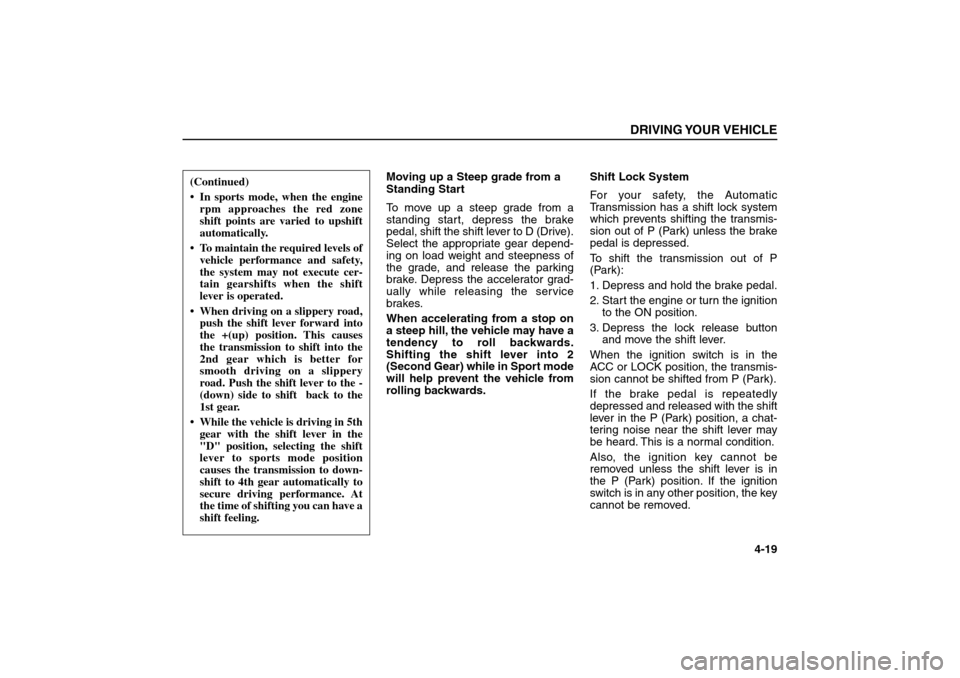
Moving up a Steep grade from a
Standing Start
To move up a steep grade from a
standing start, depress the brake
pedal, shift the shift lever to D (Drive).
Select the appropriate gear depend-
ing on load weight and steepness of
the grade, and release the parking
brake. Depress the accelerator grad-
ually while releasing the service
brakes.
When accelerating from a stop on
a steep hill, the vehicle may have a
tendency to roll backwards.
Shifting the shift lever into 2
(Second Gear) while in Sport mode
will help prevent the vehicle from
rolling backwards.Shift Lock System
For your safety, the Automatic
Transmission has a shift lock system
which prevents shifting the transmis-
sion out of P (Park) unless the brake
pedal is depressed.
To shift the transmission out of P
(Park):
1. Depress and hold the brake pedal.
2. Start the engine or turn the ignition
to the ON position.
3. Depress the lock release button
and move the shift lever.
When the ignition switch is in the
ACC or LOCK position, the transmis-
sion cannot be shifted from P (Park).
If the brake pedal is repeatedly
depressed and released with the shift
lever in the P (Park) position, a chat-
tering noise near the shift lever may
be heard. This is a normal condition.
Also, the ignition key cannot be
removed unless the shift lever is in
the P (Park) position. If the ignition
switch is in any other position, the key
cannot be removed.
DRIVING YOUR VEHICLE
4-19
(Continued)
In sports mode, when the engine
rpm approaches the red zone
shift points are varied to upshift
automatically.
To maintain the required levels of
vehicle performance and safety,
the system may not execute cer-
tain gearshifts when the shift
lever is operated.
When driving on a slippery road,
push the shift lever forward into
the +(up) position. This causes
the transmission to shift into the
2nd gear which is better for
smooth driving on a slippery
road. Push the shift lever to the -
(down) side to shift back to the
1st gear.
While the vehicle is driving in 5th
gear with the shift lever in the
"D" position, selecting the shift
lever to sports mode position
causes the transmission to down-
shift to 4th gear automatically to
secure driving performance. At
the time of shifting you can have a
shift feeling.
BL-ENG (CAN)-4.qxd 7/28/05 5:55 PM Page 19
Page 118 of 312
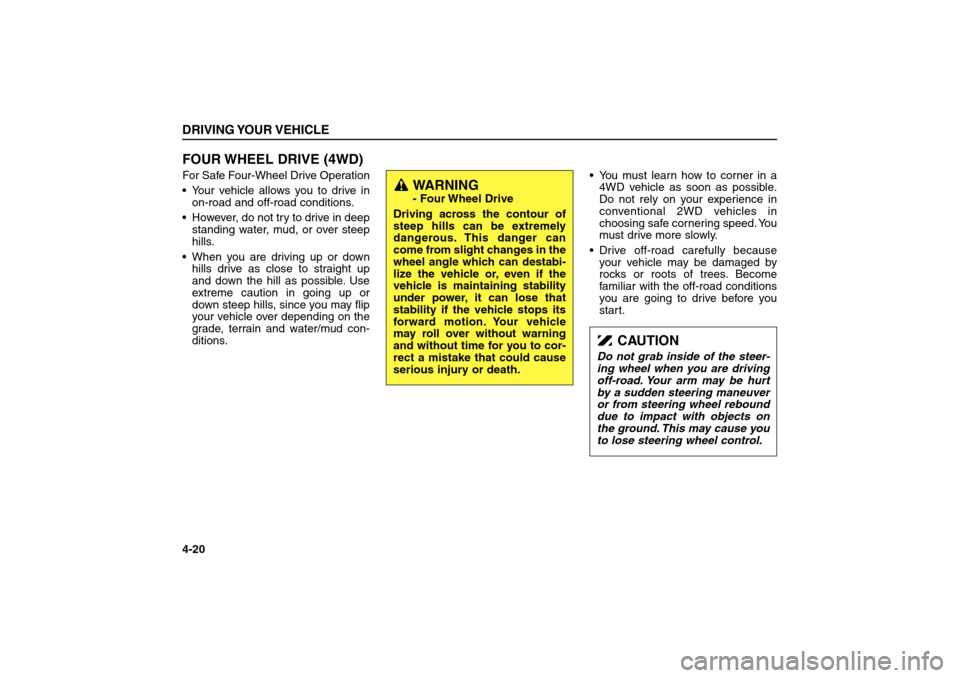
FOUR WHEEL DRIVE (4WD)For Safe Four-Wheel Drive Operation
Your vehicle allows you to drive in
on-road and off-road conditions.
However, do not try to drive in deep
standing water, mud, or over steep
hills.
When you are driving up or down
hills drive as close to straight up
and down the hill as possible. Use
extreme caution in going up or
down steep hills, since you may flip
your vehicle over depending on the
grade, terrain and water/mud con-
ditions.You must learn how to corner in a
4WD vehicle as soon as possible.
Do not rely on your experience in
conventional 2WD vehicles in
choosing safe cornering speed. You
must drive more slowly.
Drive off-road carefully because
your vehicle may be damaged by
rocks or roots of trees. Become
familiar with the off-road conditions
you are going to drive before you
start.DRIVING YOUR VEHICLE4-20
WARNING- Four Wheel Drive
Driving across the contour of
steep hills can be extremely
dangerous. This danger can
come from slight changes in the
wheel angle which can destabi-
lize the vehicle or, even if the
vehicle is maintaining stability
under power, it can lose that
stability if the vehicle stops its
forward motion. Your vehicle
may roll over without warning
and without time for you to cor-
rect a mistake that could cause
serious injury or death.
CAUTION
Do not grab inside of the steer-
ing wheel when you are driving
off-road. Your arm may be hurt
by a sudden steering maneuver
or from steering wheel rebound
due to impact with objects on
the ground. This may cause you
to lose steering wheel control.
BL-ENG (CAN)-4.qxd 7/28/05 5:55 PM Page 20
Page 119 of 312
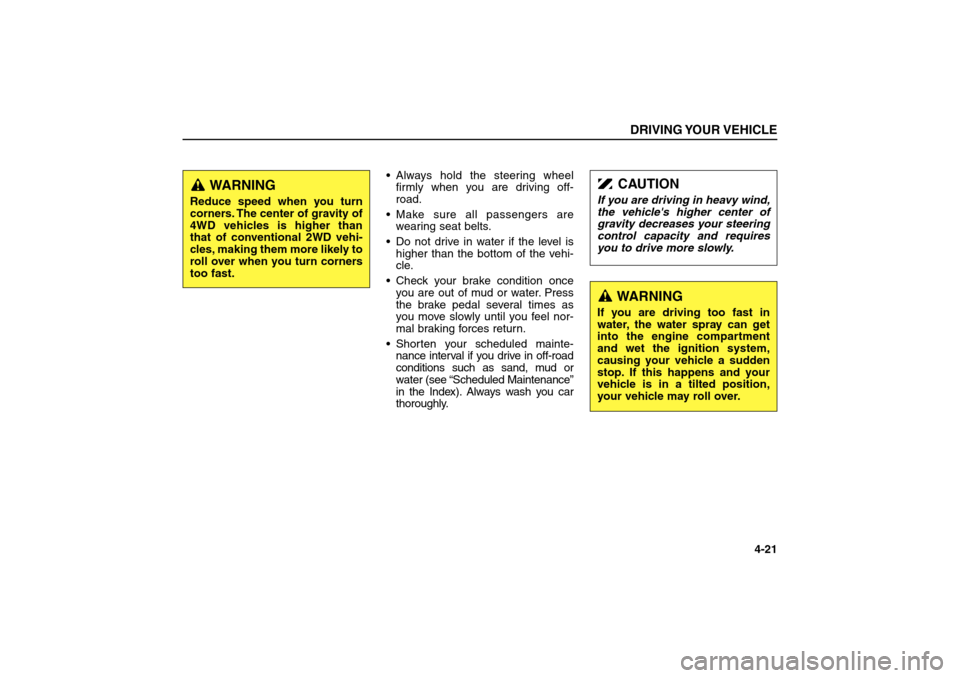
Always hold the steering wheel
firmly when you are driving off-
road.
Make sure all passengers are
wearing seat belts.
Do not drive in water if the level is
higher than the bottom of the vehi-
cle.
Check your brake condition once
you are out of mud or water. Press
the brake pedal several times as
you move slowly until you feel nor-
mal braking forces return.
Shorten your scheduled mainte-
nance interval if you drive in off-road
conditions such as sand, mud or
water (see “Scheduled Maintenance”
in the Index). Always wash you car
thoroughly.
DRIVING YOUR VEHICLE
4-21
WARNING
Reduce speed when you turn
corners. The center of gravity of
4WD vehicles is higher than
that of conventional 2WD vehi-
cles, making them more likely to
roll over when you turn corners
too fast.
CAUTION
If you are driving in heavy wind,
the vehicle's higher center of
gravity decreases your steering
control capacity and requires
you to drive more slowly.
WARNING
If you are driving too fast in
water, the water spray can get
into the engine compartment
and wet the ignition system,
causing your vehicle a sudden
stop. If this happens and your
vehicle is in a tilted position,
your vehicle may roll over.
BL-ENG (CAN)-4.qxd 7/28/05 5:55 PM Page 21
Page 120 of 312
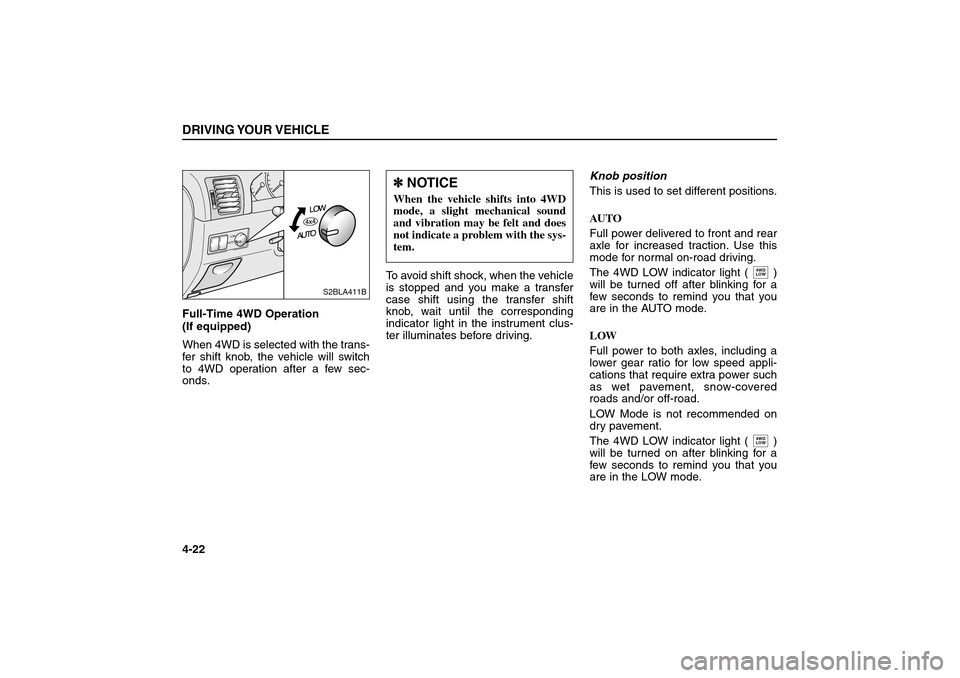
Full-Time 4WD Operation
(If equipped)
When 4WD is selected with the trans-
fer shift knob, the vehicle will switch
to 4WD operation after a few sec-
onds.To avoid shift shock, when the vehicle
is stopped and you make a transfer
case shift using the transfer shift
knob, wait until the corresponding
indicator light in the instrument clus-
ter illuminates before driving.Knob position
This is used to set different positions.
AUTO
Full power delivered to front and rear
axle for increased traction. Use this
mode for normal on-road driving.
The 4WD LOW indicator light ( )
will be turned off after blinking for a
few seconds to remind you that you
are in the AUTO mode.
LOW
Full power to both axles, including a
lower gear ratio for low speed appli-
cations that require extra power such
as wet pavement, snow-covered
roads and/or off-road.
LOW Mode is not recommended on
dry pavement.
The 4WD LOW indicator light ( )
will be turned on after blinking for a
few seconds to remind you that you
are in the LOW mode.
4WD
LOW4WD
LOW
DRIVING YOUR VEHICLE4-22
L
O
WAUTO
S2BLA411B
✽ ✽
NOTICEWhen the vehicle shifts into 4WD
mode, a slight mechanical sound
and vibration may be felt and does
not indicate a problem with the sys-
tem.
BL-ENG (CAN)-4.qxd 7/28/05 5:55 PM Page 22